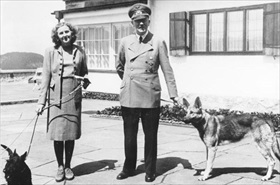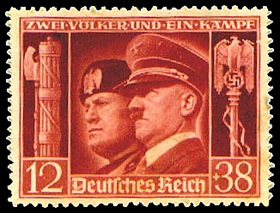HITLER PAYS STATE VISIT TO ITALY
Rome, Italy • May 3, 1938
On this date in 1938 Adolf Hitler began a 6‑day Italian state visit to Rome, Naples, and Florence in a display of Axis solidarity. The choreographed visit featured a parade by the Italian armed forces (demonstrating to German reviewers a lack of modern equipment), a review of the Italian Navy (world’s fifth largest), a horse-drawn carriage ride into Rome’s city center with its historic architecture (the Coliseum was illuminated by pyrotechnics for the drive-by), and hours-long visits to the city’s museums and galleries.
The exception to Rome’s lavish welcome mat was that of Vatican City. The year before, Pope Pius XI had damned the Nazi leader for his perfidy, his untrustworthiness, his determination to take the place of God, and his danger to German society in a March 21, 1937, encyclical titled “Mit brennender Sorge” (With Burning Concern) that was read to all Catholic parishioners that Palm Sunday. The pope chose therefore to seal off the Vatican’s art treasures during Hitler’s visit lest they be “desecrated,” going so far as to turn off the City’s lights at night. Rising above the obvious insult, “Rome captivated me,” Hitler later remarked. More annoying to the Fuehrer, it seemed, was the fact that his host for the state visit was King Victor Emmanuel III, not Prime Minister Benito Mussolini. Hitler made do with sharing the company of the king or Mussolini depending on whether the events they and their entourages attended were political or not.
This was not the first meeting between the 2 European. Hitler and Mussolini had first met in Venice on the Italian Adriatic Coast in June 1934 and 3 years later in Germany, in Munich and Berlin. During that latter visit in November 1937, Italy was prompted to join the symbolic anti-Comintern Pact (anti-Communist pact) directed against the Soviet Union, a pact that had already linked Germany and Japan.
The German leader’s 1938 visit to Italy had several important objectives, one being Hitler’s show of gratitude to Il Duce (Italian, “the leader”) for allowing, in a prearranged script, neutral Austria to be annexed to the Reich. The March 13 Anschluss (union) eliminated the buffer state between the 2 militarized dictatorships that the Duce had long preferred, a buffer that the Austrians had recently made cumbersome to Mussolini’s thinking by their political disarray. A second objective was to secure Italian neutrality when Hitler moved to occupy Czechoslovakia with its Sudeten-German minority.
The third objective was to cement a bond of “eternal friendship” between the 2 dictatorships. This friendship logically led to the “Pact of Steel” (Italian, “Patto d’Acciaio”) in 1939, which committed both countries to mutual support in the event of war, though Mussolini let the Germans know that Italy would not be ready to wage war for several more years. The Pact (originally named “Pact of Blood” which it did, in fact, become in June 1940), marked the formal creation of the Rome-Berlin Axis, giving Italy an ally sympathetic to its predatory policies in the Balkans and East Africa and Germany the ability to respond to policies of encirclement directed against it by the Western democracies—Great Britain, France, and Poland.
Mussolini and Hitler: On Route to the 1939 Blood Pact
 |  |
Left: Signing the Pact of Steel in the Reich Chancellery, Berlin, May 22, 1939. From left, sitting, Italy’s Foreign Minister Count Galeazzo Ciano, Mussolini’s son-in-law; Adolf Hitler; and German Foreign Minister Joachim von Ribbentrop. Behind Hitler, standing, is Luftwaffe chief chief Hermann Goering.
![]()
Right: Adolf Hitler with his mistress Eva Braun at the Berghof, the Fuehrer’s luxurious Bavarian retreat on the Obersalzberg, June 14, 1942. In her 1938 travel papers to Italy, the then 26‑year‑old Braun was given the fictitious title of “secretary.” Nineteen years his junior, Braun would eventually become Hitler’s wife in April 1945, 40 hours before their suicides in the Fuerhrerbunker beneath the ruins of the Reich Chancellery in Berlin.
 |  |
Left: His face expressionless, Mussolini rides in a black convertible with Hitler in Florence, Italy, May 9, 1938. City bells rang and Florentians waving banners bearing swastikas cheered the luminaries. Flying in tight formations above their 20‑car motorcade were airplanes of the Italian air force. Scrunched into Hitler’s 10 hours in Florence were visits to the Uffizi galleries and the Basilica of Santa Croce, where Michelangelo and Galileo were buried; dinner at the Palazzo Medici; and a Verdi performance. Throughout his 6 days in Italy, Hitler beamed and strutted like a peacock across his host’s stage, having pulled off his coup in Austria (Anschluss) earlier in March after Mussolini had abandoned his northern neighbor to the Nazi predator.
![]()
Right: 1941 German postage stamp of Hitler and Mussolini. Translation of text at the top: “Two Peoples and One Struggle.”
Hitler’s Visit to Italy, May 1938. Footage Begins 5 Seconds into Video
![]()

 History buffs, there is good news! The Daily Chronicles of World War II is now available as an ebook for $4.99 on Amazon.com. Containing a year’s worth of dated entries from this website, the ebook brings the story of this tumultuous era to life in a compelling, authoritative, and succinct manner. Featuring inventive navigation aids, the ebook enables readers to instantly move forward or backward by month and date to different dated entries. Simple and elegant! Click
History buffs, there is good news! The Daily Chronicles of World War II is now available as an ebook for $4.99 on Amazon.com. Containing a year’s worth of dated entries from this website, the ebook brings the story of this tumultuous era to life in a compelling, authoritative, and succinct manner. Featuring inventive navigation aids, the ebook enables readers to instantly move forward or backward by month and date to different dated entries. Simple and elegant! Click 











